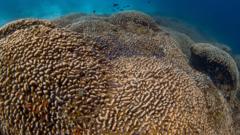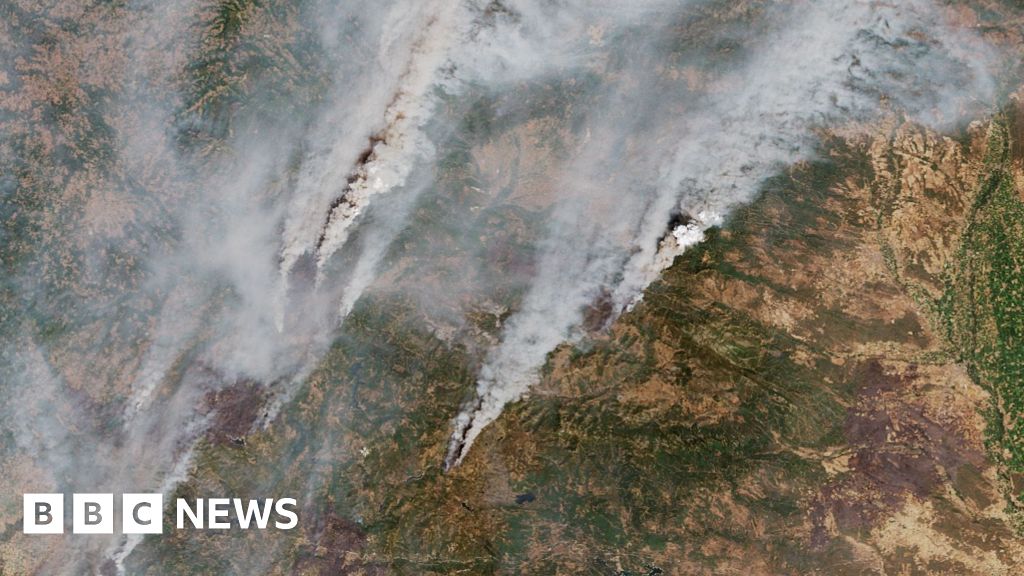In a groundbreaking finding, scientists have discovered the largest coral ever recorded in the southwest Pacific Ocean, a significant event underscoring the need for marine conservation efforts. This remarkable mega coral, a colossal organism formed from connected polyps, may be over 300 years old, dwarfing even the size of a blue whale. The historic discovery was made by videographer Manu San Felix while documenting how the region is impacted by climate change during an expedition aboard a National Geographic vessel.
On his dive off the Solomon Islands, San Felix noted the coral’s vast dimensions, measuring 34 meters wide and 5.5 meters high, calling it a "cathedral underwater." His emotional response reflects a profound respect for such a resilient life form that has existed since the days of Napoleon. Equipped with underwater tape measures, the research team confirmed its measurements and expressions of awe.
As global temperatures rise due to climate change, coral reefs, which are critical to the marine ecosystem and support the livelihoods of one billion people, face dire challenges. The newly found coral, however, is reported to be in excellent health, likely owing to its location in deeper waters, which offers protection from warmer surface temperatures.
The timing of this discovery coincided with COP29 climate talks in Baku, Azerbaijan. Solomon Islands Climate Minister Trevor Manemahaga expressed pride in the coral's discovery, emphasizing its significance for the nation’s economic stability and marine resources. The small island nation is particularly vulnerable to climate change, grappling with increasingly severe weather and erosion.
Mr. Manemahaga's remarks underline a broader call from developing nations at the summit for richer countries to provide more financial resources to combat climate change. These funds could help diversify local economies beyond logging, which constitutes a significant portion of export revenue but also pollutes marine habitats.
Following the expedition, coral scientist Eric Brown noted the extraordinary health of the newly found coral compared to nearby shallow reefs which are suffering from heat-related degradation. Identified as Pavona clavus, this gigantic coral supports various marine life and serves as a key indicator of historical oceanic conditions.
With alarming reports indicating that 44% of corals in warm waters face extinction—an increase since the last assessment—the discovery represents a ray of hope in the pursuit of preserving marine biodiversity and addressing climate change.
On his dive off the Solomon Islands, San Felix noted the coral’s vast dimensions, measuring 34 meters wide and 5.5 meters high, calling it a "cathedral underwater." His emotional response reflects a profound respect for such a resilient life form that has existed since the days of Napoleon. Equipped with underwater tape measures, the research team confirmed its measurements and expressions of awe.
As global temperatures rise due to climate change, coral reefs, which are critical to the marine ecosystem and support the livelihoods of one billion people, face dire challenges. The newly found coral, however, is reported to be in excellent health, likely owing to its location in deeper waters, which offers protection from warmer surface temperatures.
The timing of this discovery coincided with COP29 climate talks in Baku, Azerbaijan. Solomon Islands Climate Minister Trevor Manemahaga expressed pride in the coral's discovery, emphasizing its significance for the nation’s economic stability and marine resources. The small island nation is particularly vulnerable to climate change, grappling with increasingly severe weather and erosion.
Mr. Manemahaga's remarks underline a broader call from developing nations at the summit for richer countries to provide more financial resources to combat climate change. These funds could help diversify local economies beyond logging, which constitutes a significant portion of export revenue but also pollutes marine habitats.
Following the expedition, coral scientist Eric Brown noted the extraordinary health of the newly found coral compared to nearby shallow reefs which are suffering from heat-related degradation. Identified as Pavona clavus, this gigantic coral supports various marine life and serves as a key indicator of historical oceanic conditions.
With alarming reports indicating that 44% of corals in warm waters face extinction—an increase since the last assessment—the discovery represents a ray of hope in the pursuit of preserving marine biodiversity and addressing climate change.



















